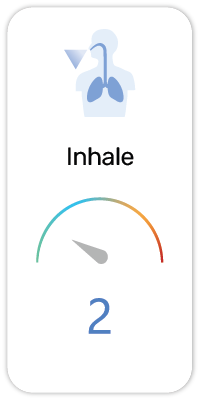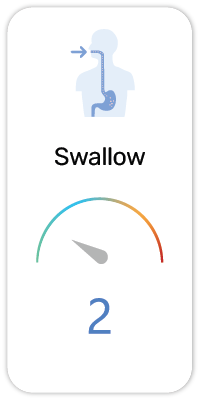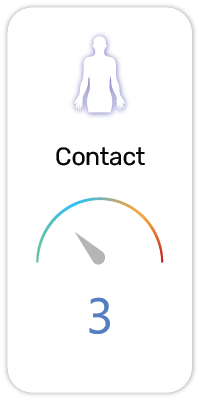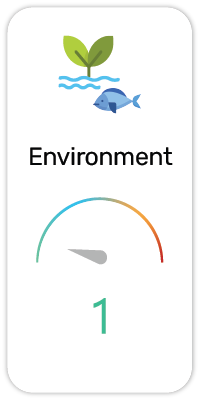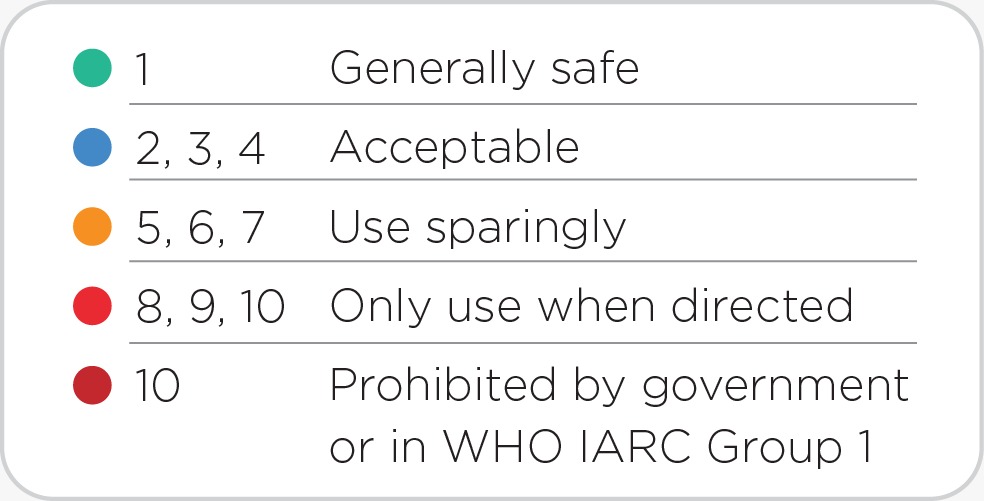Geraniol(in 11,098 products)
Potential Risk Index®:
About:
Functions:
1. Antioxidant - Reduces oxidation to prevent the formation of free radicals which may be harmful to health.
2. Flavor / Flavoring / Flavor Enhancer - Provides or enhances a particular taste or smell.
3. Fragrance / Fragrance Component - Provides or enhances a particular smell or odor.
Geraniol is a natural ingredient commonly used in personal care and cosmetic products. It is a type of alcohol that is naturally present in various plants, particularly in geraniums.
Geraniol works by providing a pleasant and floral scent to personal care and cosmetic products, making it a popular ingredient in products such as perfumes, lotions, and body washes. It is also known for its potential antioxidant and antimicrobial properties, which can benefit the skin.
Recent studies have shown that Geraniol is safe for use in personal care and cosmetic products when used in appropriate concentrations.
Apart from its use in cosmetics, Geraniol also has applications in the food and beverage industry. It is used as a flavoring agent in various products, including desserts, candies, and beverages.
Overall, Geraniol is a versatile ingredient that provides a delightful scent to personal care and cosmetic products.
Recent Findings:
Geraniol is a common component in essential oils with a rose-like odor and a floral-like taste, it is commonly found in perfumery and cosmetic products.
A review of geraniol has shown that it has biological activities such as its insecticide, anti-parasite and repellent effects, coupled with its "low mammalian toxicity" and quick biodegradation. Other pharmaceutical properties include anti-cancer, anti-microbial, anti-inflammatory and anti-oxidant. [2] [3]
A separate paper cited antiulcerogenic effects where Wistar rats were given an oral administration of geraniol which resulted in a 70% (7.50mg/kg bw) to 99% (200mg/kg bw) reduction in gastric ulcers. [4]
In combination with 5-fluorouracil, geraniol helps to inhibit the growth of human colorectal tumors [5], oral tumors in hamsters [6], as well as pancreatic tumors in both humans and hamsters. [7] [8] Geraniol appears to have an extremely potent anti-cancer effect across multiple types of tumors and species from human renal cancer [9] to rat lung cancer [10].
Geraniol also has a neuroprotective effect on acrylamide-induced neurotoxicity although more research is needed to ascertain its neuroprotection in other cases. [11]
Geraniol also has the potential to cause allergic contact dermatitis for some individuals. [12] [13] [14] Although tests conducted on "seven human predictive studies indicate a weak or absent sensitization potential". [14] There is also a possibility that geraniol can cause allergic contact cheilitis (lip inflammation). [15] [16]
Scientific References:
1. PubChem: https://pubchem.ncbi.nlm.nih.gov/compound/637566
2. Geraniol — A review of a commercially important fragrance material. (S. Afr. J. Bot., 76(4), 643–651. doi:10.1016/j.sajb.2010.05.008)
3. Plant derived antioxidants – Geraniol and camphene protect rat alveolar macrophages against t-BHP induced oxidative stress. (Toxicol. In Vitro, 23(2), 295–301. doi:10.1016/j.tiv.2008.12.014)
4. Geraniol—a flavoring agent with multifunctional effects in protecting the gastric and duodenal mucosa. (Naunyn Schmiedebergs Arch. Pharmacol., 387(4), 355–365. doi:10.1007/s00210-013-0947-z)
5. Geraniol, a component of plant essential oils, modulates DNA synthesis and potentiates 5-fluorouracil efficacy on human colon tumor xenografts. (Cancer Lett., 215(1), 53–59. doi:10.1016/j.canlet.2004.06.019)
6. Geraniol modulates cell proliferation, apoptosis, inflammation, and angiogenesis during 7,12-dimethylbenz[a]anthracene-induced hamster buccal pouch carcinogenesis. (Mol. Cell. Biochem., 369(1-2), 17–25. doi:10.1007/s11010-012-1364-1)
7. Inhibition of pancreatic cancer growth by the dietary isoprenoids farnesol and geraniol. (Lipids, 32(2), 151–156. doi:10.1007/s11745-997-0019-y)
8. The antitumor effects of geraniol: Modulation of cancer hallmark pathways (Review). (Int. J. Oncol., 48(5), 1772–1782. doi:10.3892/ijo.2016.3427)
9. Preclinical renal cancer chemopreventive efficacy of geraniol by modulation of multiple molecular pathways. (Toxicology, 290(1), 69–81. doi:10.1016/j.tox.2011.08.020)
10. Plant derived antioxidants – Geraniol and camphene protect rat alveolar macrophages against t-BHP induced oxidative stress. (Toxicol In Vitro, 23(2), 295–301. doi:10.1016/j.tiv.2008.12.014)
11. Neuroprotective effect of geraniol and curcumin in an acrylamide model of neurotoxicity in Drosophila melanogaster: Relevance to neuropathy. (J. Insect Physiol., 60, 7–16. doi:10.1016/j.jinsphys.2013.10.003)
12. Allergic contact dermatitis resulting from sensitivity to citrus peel, geraniol, and citral. (J. Am. Acad. Dermatol., 21(2), 395–397. doi:10.1016/s0190-9622(89)80043-x)
13. Allergic contact dermatitis following exposure to essential oils. (Australas. J. Dermatol., 43(3), 211–213. doi:10.1046/j.1440-0960.2002.00598.x)
14. Is There Evidence that Geraniol Causes Allergic Contact Dermatitis? (Curr. Probl. Dermatol., 3(6), 318–331. doi:10.1159/000092824)
15. Allergic contact cheilitis due to geraniol in food. (Contact Derm., 56(4), 242–243. doi:10.1111/j.1600-0536.2007.00973.x)
16. Pseudo flautist’s lip: allergic contact cheilitis from geraniol. (Contact Derm., 37(1), 39–39. doi:10.1111/j.1600-0536.1997.tb00377.x)
Regulatory References:
1. EU CosIng Annex III, SUBSTANCES WITH RESTRICTIONS IN COSMETIC PRODUCTS [2018]
- Ref: III/78
2. EU Scientific Committee on Consumer Safety
3. Japan’s List of Designated Food Additives under Article 10 of the Food Sanitation Act
- Geraniol
4. Hong Kong Consumer Council
- Geraniol - Fragrance allergen
5. International Fragrance Association Transparency List [2015]
- Geraniol
Safety and Hazards (UN GHS):
1. Causes skin irritation (H315)
2. May cause an allergic skin reaction (H317)
3. Causes serious eye damage (H318)
4. May cause drowsiness or dizziness (H336)
5. Toxic to aquatic life (H401)
6. Toxic to aquatic life with long lasting effects (H411)
7. Harmful to aquatic life with long lasting effects (H412)
Potential Health Concerns For:
1. Chromosome Breakage (PubMed ID:29745075)
2. Death (PubMed ID:13680833)
3. Dermatitis, Allergic Contact (PubMed ID:11312644)
4. Dermatitis, Contact (PubMed ID:33301901)
5. Hypersensitivity (PubMed ID:18824010)
Potential Health Benefits For:
1. Aberrant Crypt Foci (PubMed ID:21445532)
2. Acute Lung Injury (PubMed ID:29050341)
3. Anhedonia (PubMed ID:26454213)
4. Arrhythmias, Cardiac (PubMed ID:24862086)
5. Asthma (PubMed ID:27117312)
6. Atherosclerosis (PubMed ID:25218494)
7. Bradycardia (PubMed ID:34343525)
8. Breast Neoplasms (PubMed ID:30662405)
9. Candidiasis (PubMed ID:30157240)
10. Carcinogenesis (PubMed ID:8169651)
11. Carcinoma, Squamous Cell (PubMed ID:23499697)
12. Cardiomegaly (PubMed ID:25218494)
13. Cardiomyopathies (PubMed ID:25381951)
14. Catatonia (PubMed ID:24768735)
15. Chemical and Drug Induced Liver Injury (PubMed ID:22509279)
16. Colitis (PubMed ID:26973525)
17. Colitis, Ulcerative (PubMed ID:26165751)
18. Colonic Neoplasms (PubMed ID:15374632)
19. Depressive Disorder (PubMed ID:26454213)
20. Diabetes Complications (PubMed ID:28904557)
21. Diabetic Cardiomyopathies (PubMed ID:28178614)
22. Diabetic Neuropathies (PubMed ID:24752916)
23. Disease Models, Animal (PubMed ID:18391837)
24. Duodenal Ulcer (PubMed ID:24337826)
25. Dyslipidemias (PubMed ID:25679220)
26. Edema (PubMed ID:22760862)
27. Endomyocardial Fibrosis (PubMed ID:26004525)
28. Fatty Liver (PubMed ID:25218494)
29. Fibrosis (PubMed ID:28904557)
30. Glucose Intolerance (PubMed ID:25679220)
31. Hyperalgesia (PubMed ID:24752916)
32. Hypercholesterolemia (PubMed ID:28178614)
33. Hyperglycemia (PubMed ID:25679220)
34. Hyperinsulinism (PubMed ID:31005848)
35. Hyperlipidemias (PubMed ID:25218494)
36. Hyperplasia (PubMed ID:22760862)
37. Hypertension (PubMed ID:25679220)
38. Hyperuricemia (PubMed ID:25679220)
39. Hypokinesia (PubMed ID:24768735)
40. Inflammation (PubMed ID:18391837)
41. Insulin Resistance (PubMed ID:31005848)
42. Leukemia (PubMed ID:10082788)
43. Leukemia P388 (PubMed ID:1988098)
44. Liver Cirrhosis (PubMed ID:26004525)
45. Liver Failure, Acute (PubMed ID:30550845)
46. Liver Neoplasms (PubMed ID:20435455)
47. Liver Neoplasms, Experimental (PubMed ID:7472655)
48. Long QT Syndrome (PubMed ID:34343525)
49. Lung Neoplasms (PubMed ID:24875281)
50. Melanoma, Experimental (PubMed ID:1988098)
51. Metabolic Syndrome X (PubMed ID:25679220)
52. Mevalonate Kinase Deficiency (PubMed ID:18391837)
53. Motor Skills Disorders (PubMed ID:23943375)
54. Mouth Neoplasms (PubMed ID:21801490)
55. Movement Disorders (PubMed ID:23943375)
56. Myocardial Reperfusion Injury (PubMed ID:28131760)
57. Neoplasms (PubMed ID:21907755)
58. Neoplasms, Experimental (PubMed ID:21371438)
59. Neoplasms, Mesothelial (PubMed ID:30662405)
60. Neovascularization, Pathologic (PubMed ID:26154255)
61. Neuralgia (PubMed ID:28334550)
62. Neurobehavioral Manifestations (PubMed ID:25199698)
63. Neurotoxicity Syndromes (PubMed ID:24231732)
64. Non-alcoholic Fatty Liver Disease (PubMed ID:26695085)
65. Obesity (PubMed ID:25679220)
66. Pain (PubMed ID:27277137)
67. Pancreatic Neoplasms (PubMed ID:30662405)
68. Paralysis (PubMed ID:28915354)
69. Parkinson Disease, Secondary (PubMed ID:23943375)
70. Parkinsonian Disorders (PubMed ID:27026137)
71. Precancerous Conditions (PubMed ID:20435455)
72. Prostatic Diseases (PubMed ID:28904557)
73. Prostatic Neoplasms (PubMed ID:21371438)
74. Pulmonary Edema (PubMed ID:29050341)
75. Rhinitis, Allergic (PubMed ID:30254419)
76. Seizures (PubMed ID:17976969)
77. Skin Diseases (PubMed ID:23399806)
78. Skin Neoplasms (PubMed ID:22760862)
79. Spinal Cord Compression (PubMed ID:28334550)
80. Spinal Cord Injuries (PubMed ID:28105094)
81. Splenomegaly (PubMed ID:26165751)
82. Squamous Cell Carcinoma of Head and Neck (PubMed ID:21801490)
83. Stomach Ulcer (PubMed ID:24337826)
84. Tinea (PubMed ID:25414073)
85. Tongue Neoplasms (PubMed ID:23499697)
86. Ventricular Dysfunction, Left (PubMed ID:28178614)
87. Weight Loss (PubMed ID:26165751)
User Comments:
Submit


